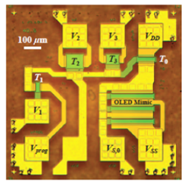Background
The implementation of Thin-film Transistors (TFTs) in active-matrix liquid crystal and organic light-emitting diode (AMOLED) displays has created a $100B flat-panel display market. For AMOLED, a simple 2-TFT pixel circuit does not operate with sufficient electrical stability to maintain a constant OLED drive current that results in poor pixel uniformity across the display. Various pixel circuits and driving schemes have been proposed to compensate for this electrical instability including current-programming, voltage-programming, optical-feedback, and external compensation. Current-programmed pixel circuits can compensate for the electrical instabilities but the programming speed is relatively slow. External driver and optical feedback compensation are complicated and expensive with limited resolution. Compensation circuits with two transistors in series with the light emitter require higher power operation for the same operating current, reducing the energy efficiency of the system.
Description of the invention
University of Waterloo researchers have invented and demonstrated a voltage programmed addressing pixel circuit to control the electrical stability of the drive thin-film transistor and the light output of an emissive LED display. This circuitry controls the current applied to an active LED while self-compensating for any threshold voltage shift of the drive TFT, utilizing a charge-transfer process. This thin-film transistor circuitry will drive and dynamically compensate the current and voltage output required for large-area electronic systems on flexible platforms with relatively simple circuitry that operates with low-power consumption.
Advantages
Our technology integrates the compensation circuitry into the backplane electronics of a display, reducing the cost of the driver electronics and simplifying the system integration of the circuitry. The resulting technology provides longer display operational lifetimes and promises to integrate easily into emerging flexible electronic circuits, enabling inexpensive flexible displays having long operating lifetimes, high energy efficiency, and provide electrical stability for conformal and wearable electronics.
Potential applications
- Displays (television, cell phone, and computer)
- Flexible electronics
- Wearable electronics
- Solid-state lighting

Reference
8810-7378
Inventors
William Wong
Maofeng Yang
Nikolas Papadopoulos
Manoj Sachdev
Patent status
Issued U.S. patent and pending in Canada
Stage of development
Ongoing research and next generation prototype development
Contact
Scott Inwood
Director of Commercialization
Waterloo Commercialization Office
519-888-4567, ext. 43728
sinwood@uwaterloo.ca
uwaterloo.ca/research